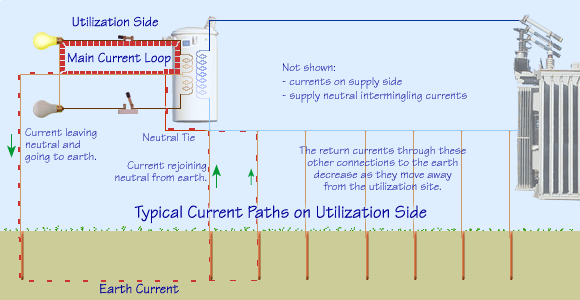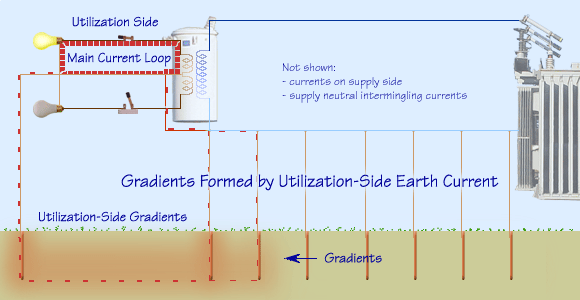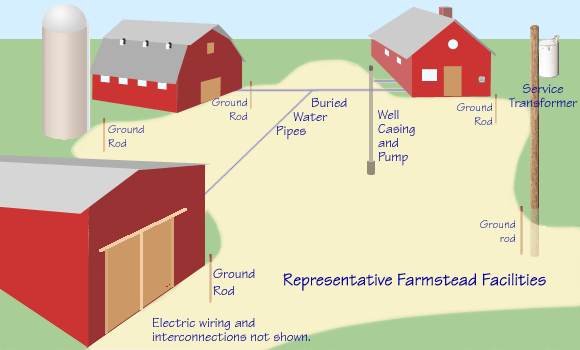Utilization-Side Gradients |
|
|
|
Utilization-side gradients form in the earth on the user side of the
power system
[SV Origins].
These user-side circuits, like the supply-side circuits, are invariably grounded for the safety of humans
and animals. As we have seen in the case of the supply side,
whenever there is grounding on an operating electrical system, there will be earth currents.
|
|
The illustration below shows, in a simple
case involving few ground rods, how the current circulates through
the earth in parallel with the neutral wire. The division of the current
between the neutral wire and the earth depends on the relative
resistances of the neutral wire path and the earth path. |





|
 
|
|
The utilization current from the transformer flows first to the appliance over the insulated energized conductors.
The majority of return current travels back to the transformer (the utilization source) on the designated
neutral wire. The remainder of the neutral return current, however, has the opportunity
to leave the neutral conductor and enter the earth at every available connection to the earth.
This earth current travels to the vicinity of the transformer and reenters the
utilization-side network through the transformer ground rod and other nearby connections to the earth. It travels up the
pole and joins the neutral current just before entering the
transformer to complete the electric circuit loop.
|
|
Removing all of the utilization-side earth connections would interrupt the path through
the earth and stop the earth current. This removal, however, would
be in violation of many codes and contrary to safe electrical wiring practices.
In real life, there are many grounds at the farmstead that cause earth current.
Any attempt at stopping earth current would most likely not be successful and would
significantly impair the safety of the system.
|
 
|
|
There are many grounds on the supply side of the power system that help utilization
current flow through the earth and return to the source transformer.
The diagram above shows that earth current can flow up the many grounds on the
supply side, collect on the supply-side neutral, and rejoin the utilization-side
current through the neutral tie at the transformer.
The most significant of these supply-side grounds are generally the ones closest
to the transformer. The others
lose relevance
as the rods gain distance from the farmstead because the additional
resistance encountered gradually cancels out their ability to conduct current. |
|
As is the case with the supply side, some earth current on the utilization side is inevitable when operating a safely grounded electrical system. As this current
flows through the earth, it creates voltage gradients on the farmstead
as shown below. |





|
 
|
|
The illustration above is a simplified diagram that outlines the mechanics of
utilization-side earth currents. The farmstead typically has many more
connections to earth than have been shown. In a typical dairy farm,
there are numerous structures and buildings as shown below. |





|
 
|
|
Each of these structures may include a code-required outdoor grounding electrode.
The structures themselves may act as grounding electrodes if they are made up
of conductive elements such as structural steel.
To simplify the presentation, we focus in this review on conventional
electrodes around the farmstead—ground rods and pipes—and on
the open areas in and around the farmstead .
A similar and perhaps even more complex system of grounding electrodes may
exist inside the buildings themselves (e.g. stanchion pipes, stall dividers, indoor plumbing, etc.), but the results are similar.
|
|
Some grounding electrodes, although unintentional, play a large role
in the grounding quality at a farmstead. These include metallic water
pipes and the water well, which often incorporates a metallic casing
reaching to the ground water deep in the earth. |
 
|
|
Current can flow from these grounding conductors into the earth,
causing voltage gradients to
form in the earth around the farmstead. These voltage gradients are
typically of the spreading type, mostly associated with ground rods
[Ground Rod Gd]
or pipes
[Pipe Gd].
Ground rod and pipe gradients combine to form
a complex gradient pattern [Combined Gd].
|
|
|





|
